Trouble with STI Triples

Triple cranks are a good choice for some riders. The most common shifting system for triple cranks, Shimano’s STI, only works with Shimano chainrings. Unfortunately, Shimano’s chainring combinations are of limited use to most riders. If you want to customize your chainring sizes, you will have to use downtube or bar-end shifters, plus a front derailleur with a smooth inner cage, to make more useful triple cranks work.
On current-production road bikes, triples have almost become obsolete, because 11-speed cassettes provide such a large gear range that a third chainring no longer is needed. SRAM doesn’t even make “road” triples, but Shimano still offers them, and Campagnolo did so until recently.
Even with 10-speed cassettes, triples remain a good choice for loaded bikes and/or slower riders. These bikes and riders need a relatively small “base gear,” yet they still pedal at high speeds on slight downhills and with strong tailwinds, so they need reasonably large gears, too.
For these riders, it makes sense to have a large “top speed” chainring, a middle “cruising” chainring, and a small “climbing” chainring for steeper hills. (Stronger riders can combine the “top speed” and “cruising” chainrings into a single chainring and use a compact double.)
For triples to work well, you want to select your chainrings based on your riding style. However, Shimano offers only a single combination: 50-39-30. This is an odd combination: A rider who finds the relatively small 39-tooth “cruising” chainring useful will probably need a “climbing” chainring with fewer than 30 teeth.
More useful triple chainring combinations would be 46-40-26 or 44-38-24, with large rings small enough to be useful for normal riders, with middle rings sized for general riding, and small rings that allow climbing steep hills at low speeds.
One of the appeals of our René Herse cranks is the custom gearing. You can choose any ring combination from 24 to 50 teeth. The René Herse crank is designed to drop right into the clearances of a modern crank, so you can replace your existing crank with one that has more appropriate gearing. The René Herse cranks work great for most riders, with one exception: riders who use Shimano STI with a triple. It took us a while to figure out why STI triples are so troublesome.
After doing a lot of testing, we found that there are two separate problems. One concerns front derailleurs, the other is related to the way STI executes front shifts.
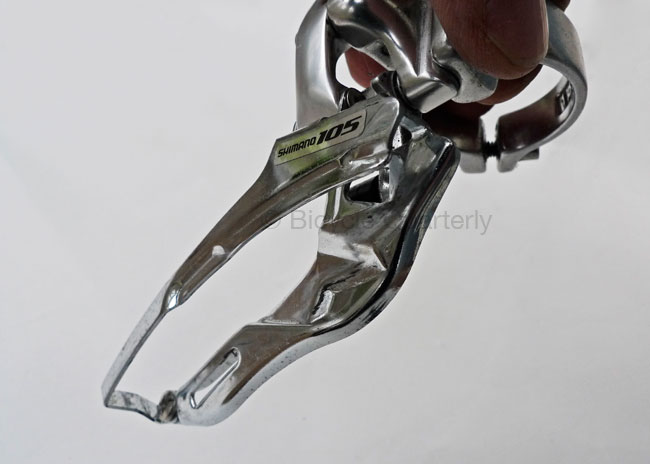
Many front derailleurs for triples have a channel pressed into the inner cage. This is designed to lift the chain onto the big chainring when you upshift. It works only if the channel matches the position of the chain on the middle ring. A derailleur like this works only with a very narrow range of chainring combinations.
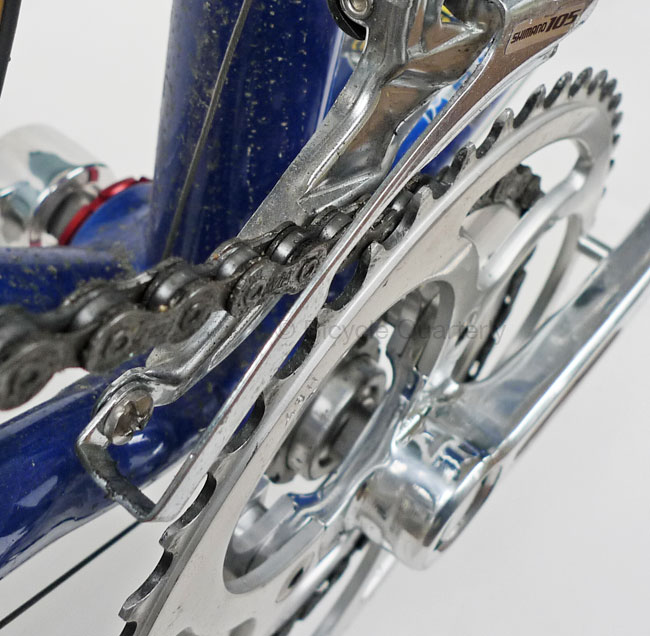
If you use a differently-sized middle ring, the channel no longer lines up with the chain as you start the shift. In the photo above, the channel is above the chain. The chain gets stuck below the channel, and it’s almost impossible to shift to the large ring.
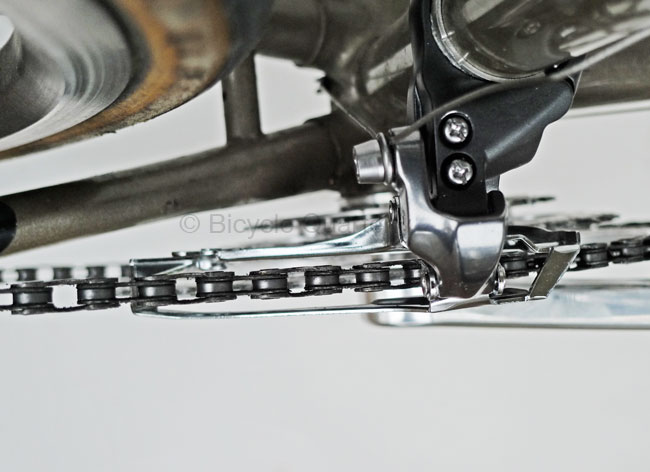
The solution to this problem is simple: Use a front derailleur for doubles, which has a smooth cage and no channels (above).
Won’t the lack of channels and other “shift aids” make it shift poorly? Front shifts are not demanding: The derailleur only needs to push the chain into the rotating teeth of the larger chainring, which picks up the chain and executes the shift. A front derailleur does not need a complex shape to work well.
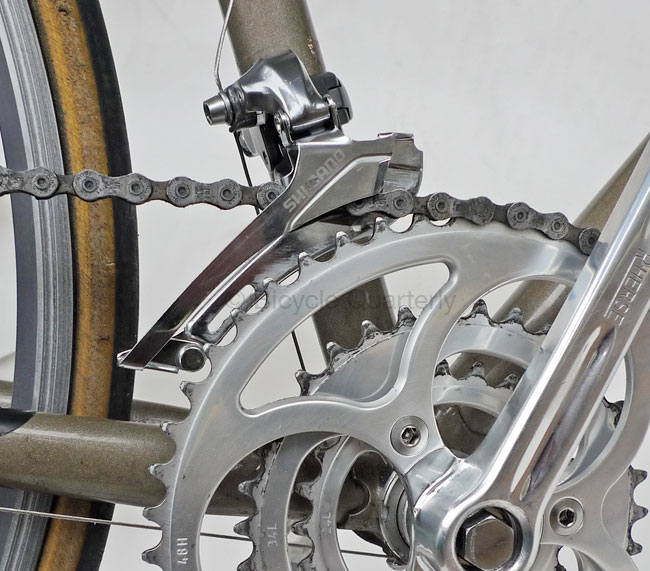
A good option is the Shimano CX-70 front derailleur (above). This derailleur is designed for cyclocross bikes with smaller chainrings, so its curve matches that of the smaller rings, and its cage is short enough that it doesn’t hit the chainstays, which can happen when you use standard derailleurs with small chainrings. The CX-70 derailleur is a great choice, whether you run a double or a triple.
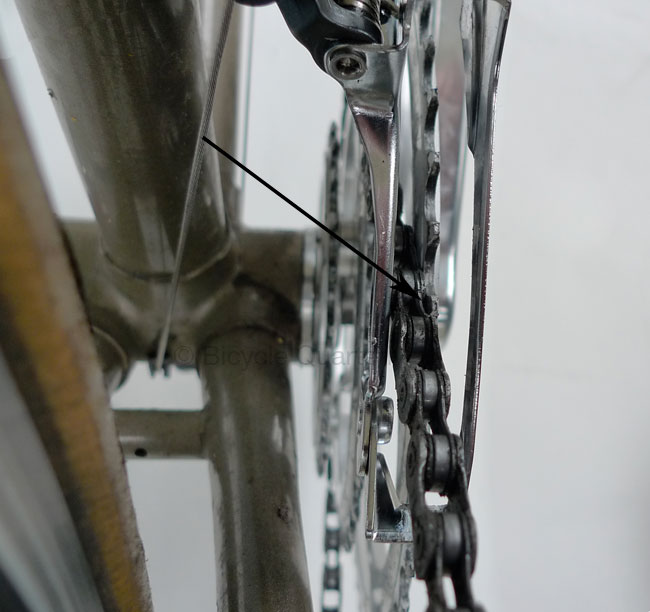
Using a front derailleur with a smooth cage addresses one problem, but another problem remains: During shifts from the small to the middle ring, to prevent the chain from overshifting straight onto the big ring, triple levers for STI/Ergopower move the chain only part-way, just far enough for a pin on the middle ring to pick up the chain.
This is very different from how shifters for two chainrings work: The derailleur pushes the chain sideways until it catches on any tooth of the larger chainring. The chain then is lifted up and threads itself onto the larger chainring, no matter how the teeth are aligned.
Now you see why STI and Ergopower triples won’t work with our cranks: Without properly designed ramps and pins, the derailleur won’t move the chain far enough to be picked up by the next chainring! Many aftermarket chainrings with “cosmetic” pins and ramps that are not aligned in the optimal chain path also will not work well with STI. (Sometimes, careful setup can make it sort of work, but the shifting won’t be as reliable.)
Why don’t we make triple-crank chainrings with ramps and pins? To offer truly outstanding shifting performance, ramped-and-pinned chainrings must be designed in matched sets. The appeal of the Rene Herse cranks is that you can mix and match chainrings as you like, but that means that there simply are too many possible chainring combinations. We’d have to make hundreds of different chainrings!
Conclusions:
- If you want to use STI/Ergopower and triple cranks, you have to stick with Shimano’s stock cranks and chainrings, whether the gear ratios work for you or not.
- If you want to use a triple with custom gearing, use downtube or bar-end shifters. Make sure you use a smooth-cage front derailleur no matter which shifting system you use.
- If you don’t want to give up STI/Ergopower, maybe an ultra-compact double will work better for you. A 44-28 may give you more useful gears than Shimano’s triple chainring combinations.
What about STI for double cranks?
Shimano’s STI for double chainrings shifts fine with chainrings that don’t have pins and ramps, but for optimum shifting performance, we now offer the Rene Herse 9/10/11-speed cranks with ramped-and-pinned chainrings.
Addition (3/7/2015): A reader pointed out that the “top pull” version of the CX-70 derailleur does not swing far enough to shift a triple crank. Only the standard “bottom pull” version works for triples.
Further reading:
– Blog post on How to select your chainrings.
– How Ramped Chainrings Work. Bicycle Quarterly Vol. 11, No. 2.
– More information about Rene Herse cranks.


